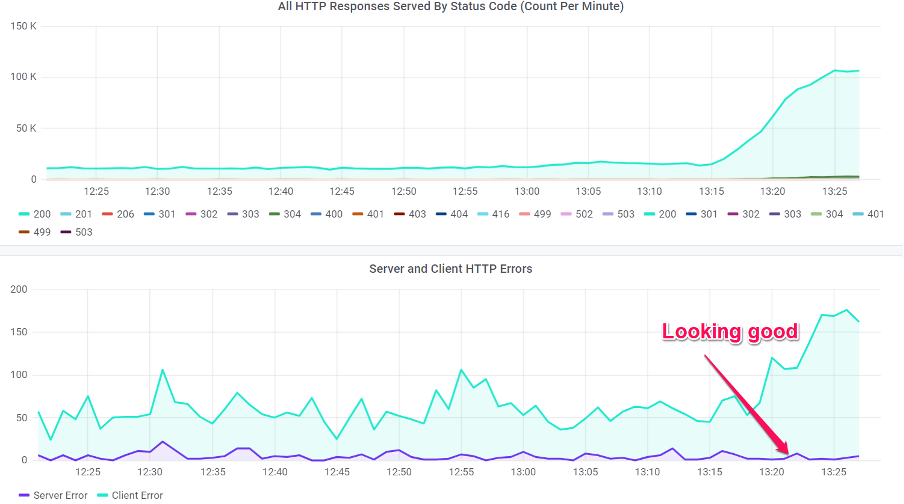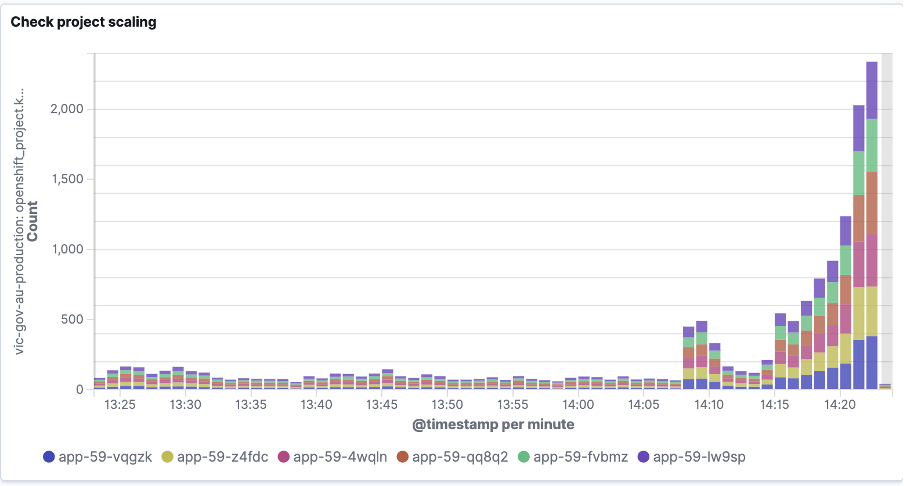
On this page:
At a glance
2020 - 2021
2 to 4 months
Completed
Single Digital Presence
State government
Discovery & strategy, Support & optimisation, Technical advisory
Whole of government, Web development, Headless CMS, Content management systems
User needs, Multidisciplinary teams, Tools & systems, Security, Open standards & common platforms, Open source, Testing, Measure performance
Overview
SDP’s challenge
During his daily pandemic briefings, the Victorian Premier directed citizens to government websites for more information. Request volumes on the SDP increased by around 4000%, to 400,000 requests per minute in the space of 30 seconds.
SDP’s transformation
Salsa, , and set up scaling and caching strategies to meet the significant increases in traffic. We preemptively scaled up origin resources and edge resources, and also put in place a caching strategy to achieve a 99% cache offload rate that ensured origin remained operational.
The outcomes
- The SDP can handle rapid ramp ups of traffic
- New incident response strategy created to meet traffic demands
- Tailored caching solution that empowers the decoupled architecture of SDP
- Process improvements and new burst capacity for high traffic events
Full case study
Below is more information on the challenge, transformation and outcomes.
SDP’s challenge — massive traffic surges
The COVID-19 pandemic changed the way we consume content. It introduced a transition period where web channels were the primary delivery mechanism for information to citizens. Government officials made announcements, with more detailed information available via website content. This drove huge amounts of traffic to government websites all at once.
This changed the traffic profile of websites from a standard request volume, to volumes that resembled distributed denial of service attacks. Request volumes on the SDP increased by around 4000%, going from roughly 10,000 requests per minute to 400,000 requests per minute in the space of 30 seconds across the platform.
Below: Request volume ramp up at edge
Below: Origin traffic request volume
SDP’s transformation — refined architecture for improved performance
Salsa, , and worked together to meet these large traffic spikes. We tackled the issue by both pre-incident planning and then post-incident planning to refine our processes and continually improve.
Pre-incident planning
We made the following refinements to the technology architecture of the SDP :
Auto-scalable workloads
Origin clusters define horizontal pod autoscalers that are configured to add more computing resources automatically based on CPU utilisation of the web workload.
Edge workloads are deployed to Section’s edge Kubernetes service, which allows for automated scaling events to be triggered and more caching nodes to be added as traffic increases.
Caching strategy
We worked to define an effective caching strategy for the web properties. The strategy involved using cache tags generated by Drupal and surfacing them via decoupled frontends. This allowed Drupal to issue invalidation requests for all connected devices and enabled content change during high traffic events without service interruption.
This strategy allowed us to achieve a 99% cache offload rate, which ensured that origin remained operational during traffic peaks
We also set up a regular load testing process
Post-incident strategy
After each event we entered into a retrospective and blameless post-mortem to analyse how the team and systems handled the traffic event and identify areas of improvement that we could make for the next one.
Some of the key activities included:
Log monitoring and alerting processes
High traffic event response team — due the nature of how the events were triggered we could form a team to review and monitor platform services during events and:
Preemptively scale up origin resources
Preemptively scale up edge resources
The outcomes — an even more resilient platform
- Platform that can handle rapid ramp ups of traffic
- New incident response strategy —used these events as inputs to define a response strategy that involves:
- Preemptively engaging team members where possible
- Preemptively scaling workloads (both origin and edge) prior to the event to give more compute capacity and headroom
- Tailored caching solution that empowers the decoupled architecture of SDP
- Process improvements and the introduction of burst capacity to monitor and be on stand-by during high traffic events
About SDP
Victoria’s Single Digital is the whole-of-government digital platform run by Victoria's Department of Premier and (DPC). DPC is responsible for several elements of Victoria’s digital engagement, including , , and .

